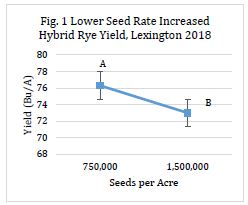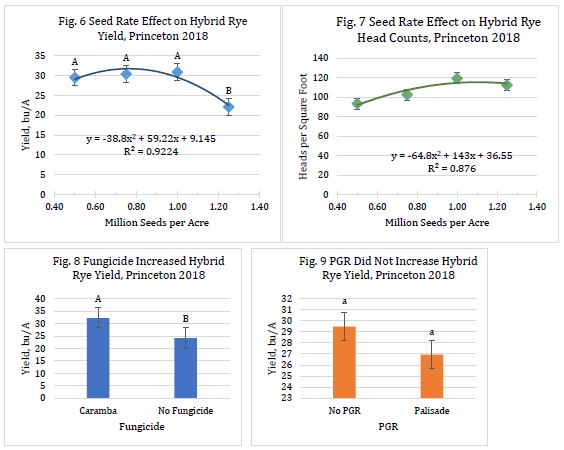Hybrid Rye Research Report in Kentucky 2017-2018
Chad Lee, Carrie Knott and Julia Santoro, University of Kentucky
Hybrid rye trials were established at Princeton and Lexington to compare seeding rates, growth regulators and fungicide applications. The growth regulator was supposed to reduce lodging, while the fungicide was supposed to reduce Fusairum head blight (head scab).
Seeding rates included 750,000 and 1,500,000 seeds per acre at Lexington and 500,000, 750,000, 1000,000 and 1,500,000 seeds per acre at Princeton. Palisade plant growth regulator (PGR) applied at Feekes 3 growth stage at 14.4 fluid ounces per acre. Caramba fungicide was applied at anthesis (Feekes 10.51) at 8 fluid ounces per acre. Each treatment was replication four times at each location.
Lexington
Yield at Lexington ranged from 70 to 80 bushels per acre. There were no interactions between seeding rate, plant growth regulator and fungicide. That allowed us to average yields for each treatment across the others.
The lower seeding rate of 750,000 seeds per acre increased yields by about 3 bushels per acre at Lexington (Figure 1). When yields were averaged across fungicide treatments, the Caramba application resulted in 80.3 bushels per acre while the non-treated check was 11.2 bushels less (Figure 2). Palisade had no significant effect on yield (Figure 3). The higher seeding rate resulted in more lodging (Figure 4), which is part of why the lower seeding rate resulted in better yields. Caramba increased test weight (Figure 5), which may explain why yields were higher for the fungicide application.
Princeton
Hybrid rye yields are Princeton were only about 25 to 35 bushels per acre. The optimum seed rate at Princeton was about 800,000 seeds per acre (Figure 6). Head counts continued to increase until about 1,000,000 seeds per acre, but ranged from 93 to 119 heads per square foot (Figure 7). All head counts in this range should be acceptable. Nearly all hybrid rye plants lodged at Princeton, likely contributing to the overall low yields.
Caramba fungicide increased yields at Princeton by about 8 bushels per acre (Figure 8). Palisade did not affect yields at Princeton (Figure 9).
Management Conclusions
The seeding rates confirmed that lower rates will yield excellent rye yields. Seed rates nearly half of what we target for wheat should be acceptable for hybrid rye. While rye is supposed to be more tolerant to Fusarium than wheat, Fusarium head blight pressure was heavy at both locations. Caramba increased yields at both locations in a very wet spring. Palisade plant growth regulator did not improve rye yields at either location in the 2018 harvest season. Perhaps a plant growth regulator could be helpful in other seasons with different weather. Perhaps a growth regulator is best suited to northern latitudes where rye maturation is two to three months longer than in Kentucky.
Hybrid Comparisons
Table 1. Hybrid Rye Yields, Lexington 2018
Six hybrids were seeded at Lexington in 2017. Management was identical across all six hybrids, each of which were replicated five times. Brasetto from KWS and Mephisto from Saaten Union were to two highest yielding hybrids. Cossani was the lowest yielding in this test. We plan to use Brasetto in future trials.
Management included 750,000 seeds per acre, 120 lb N per acre (60 lb N/acre applied at Feekes 3 and 60 lb N/acre applied Feekes 5).
Final Observations
The 2017-2018 growing season was challenging for small grains. Most fields, including our trials, were planted late because of excessive rainfall. Winter was extremely cold, so the late-planted rye had little chance for growth until his spring. Spring was wet and extremely hot during part of seed fill. That weather combination increased disease pressure from Fusarium. So, the extremes of 2017-2018 make using these observations, alone, dangerous.
We learned that a fungicide increased yields when Fusarium pressure is high. We need to learn more about other fungicides and timing.
Thank you to the Kentucky Small Grains Promotion Council for the funding.




